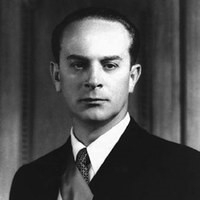Quetzaltenango (Guatemala), 1913 – Mexico City (Mexico), 1971
By Edelberto Torres-Rivas
 Colonel Jacobo Arbenz Guzmán was the second president during the period known as the Revolutionary Decade in Guatemala. In October 1944, a popular uprising of civilians and soldiers, called the October Revolution, ended the long liberal-oligarchic period. This revolution expressed deep social discontent, with Arbenz representing and guiding the young officer corps of the Army, leaving their posts at the Military Academy to lead the successful insurrection. The son of a Swiss middle-class immigrant from the provinces, Arbenz had a strong personality and was married to an aristocratic Salvadoran woman. He is considered a remarkable personal example of political coherence, with an ideological trajectory that evolved from youthful rebellion to radical left-wing nationalism.
Colonel Jacobo Arbenz Guzmán was the second president during the period known as the Revolutionary Decade in Guatemala. In October 1944, a popular uprising of civilians and soldiers, called the October Revolution, ended the long liberal-oligarchic period. This revolution expressed deep social discontent, with Arbenz representing and guiding the young officer corps of the Army, leaving their posts at the Military Academy to lead the successful insurrection. The son of a Swiss middle-class immigrant from the provinces, Arbenz had a strong personality and was married to an aristocratic Salvadoran woman. He is considered a remarkable personal example of political coherence, with an ideological trajectory that evolved from youthful rebellion to radical left-wing nationalism.
Arbenz served as Minister of National Defense under Juan José Arévalo’s government and won the presidency in the 1951 election as a candidate for a democratic-popular front. He was committed to a revolutionary program centered on reforming the old land ownership structure, a cause to which he dedicated himself with fervent passion. His friendships with intellectual leaders of the Guatemalan Labor Party (PGT), a communist-leaning party, undoubtedly reinforced his radical political stance. He notably advocated for the expropriation of 500,000 acres owned by the United Fruit Company, leading to serious clashes with U.S. policy. Critics felt that Arbenz’s policies exceeded the permissible limits of the Cold War. Following the 1953 coup against Mosadegh in Iran, the CIA achieved a victory over Arbenz in 1954, forcing him to resign and bringing an end to the democratic process in Guatemala.



